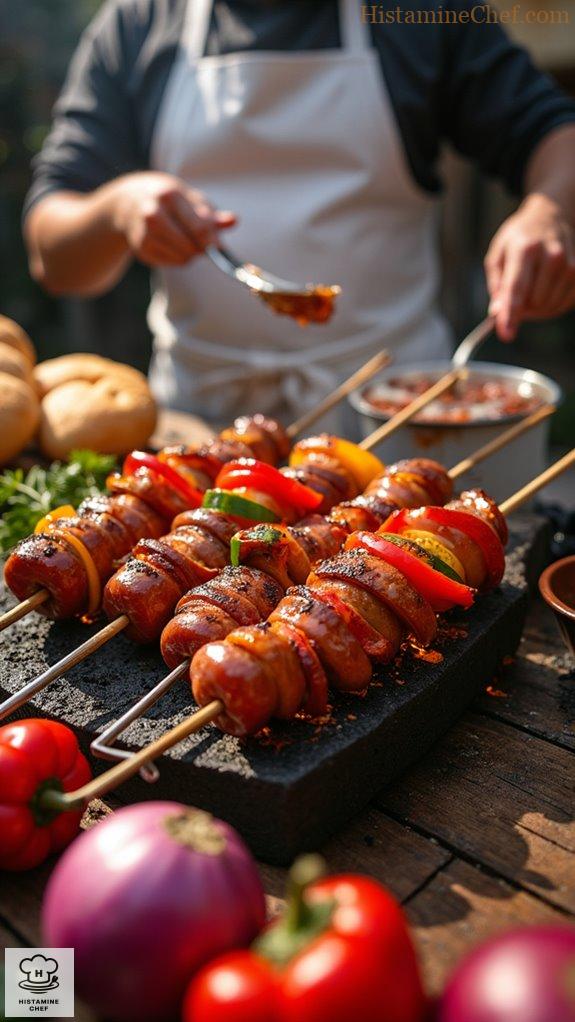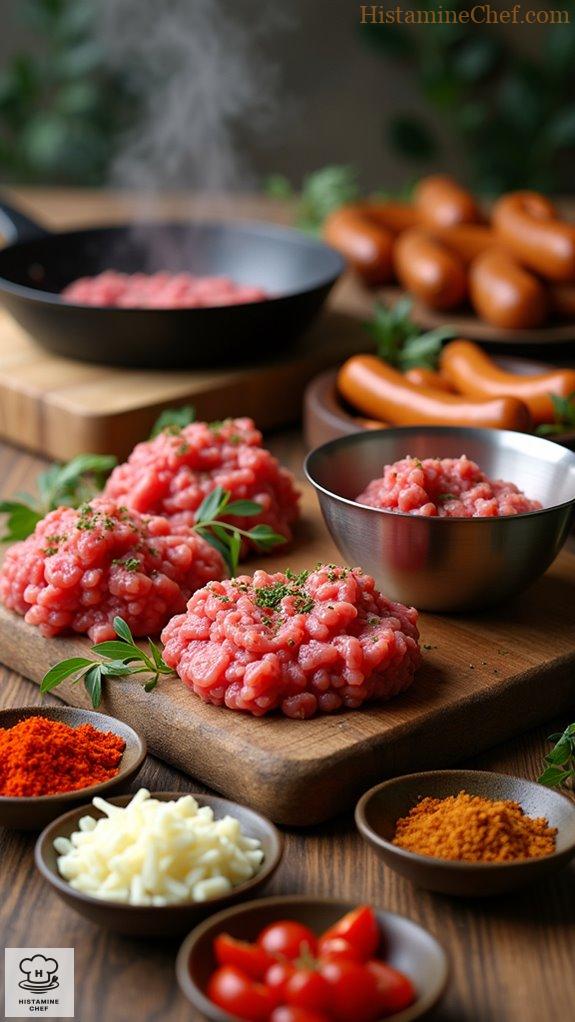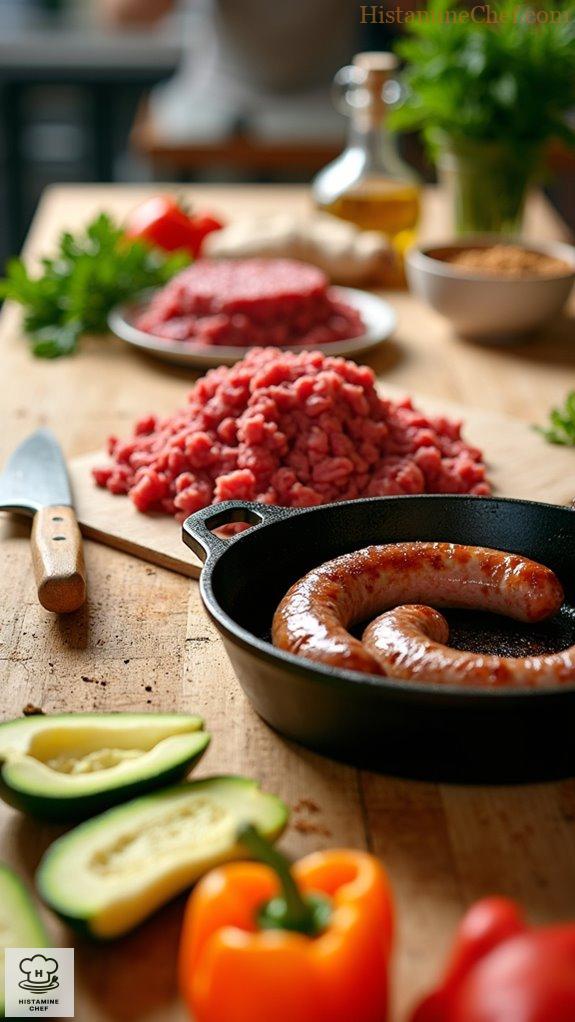To whip up a scrumptious lower histamine Moroccan merguez, I start with fresh ground meat—think lamb or beef—blended with coriander, paprika, and a hint of garlic for a flavor explosion. I form them into sausages and grill them over smoky charcoal. Skipping processed ingredients means my tummy stays happy, while these golden-brown beauties served with fresh herbs will make anyone’s mouth water! Curious about more tantalizing ways to enjoy this dish? Keep exploring!
Vibrant Souks of Marrakech

Marrakech, with its vibrant souks, is a sensory paradise where the aroma of spices and sizzling meats fills the air, reflecting a rich history of street food culture that dates back centuries.
The bustling markets are a tapestry of colors and sounds, where local vendors skillfully prepare traditional foods, showcasing Moroccan culinary artistry. One of the highlights is Merguez, a flavorful spicy sausage made from lamb or beef, often grilled to perfection and served in wraps or with bread alongside tangy dips.
Street food in Marrakech not only satiates hunger but also acts as a social hub where people gather, share stories, and celebrate the melting pot of cultures—Berber, Arab, and French—that have influenced Moroccan cuisine.
The practice of enjoying food from street stalls has deep roots in Moroccan history, stemming from the necessity of affordable dining options and the communal aspect of sharing meals, which fosters connection among locals and visitors alike.
Exploring the souks and indulging in Morocco’s vibrant street food not only offers a taste of authentic flavors but also an immersive experience into the country’s cultural heritage.
Grilled Over Open Charcoal

Street vendors cook Moroccan Merguez by first ensuring their charcoal grill is sufficiently heated, using high-quality charcoal for an even flame.
They skewer the spicy Merguez sausages onto long metal skewers, taking care to leave space between each sausage for better heat distribution.
As the sausages cook, they turn them frequently to achieve an even char and to maintain juiciness.
The aroma of the spiced meat wafts through the air, enticing passersby.
Vendors often serve the Merguez hot, nestled in freshly baked bread or alongside a medley of local vegetables, sometimes offering a drizzle of harissa for an additional kick.
Ingredients:
- 500g Merguez sausages
- 4 large fresh rolls
- 1 cup mixed bell peppers
- 1 cup sliced red onions
- 1 tablespoon harissa (optional)
- Olive oil for brushing
- Fresh parsley for garnish
- Lemon wedges for serving
Cooking Steps:
- Heat charcoal grill until hot.
- Skewer Merguez sausages onto metal sticks.
- Brush sausages lightly with olive oil.
- Place skewers over hot charcoal.
- Turn sausages frequently for even cooking.
- Cook until browned and cooked through.
- Serve in fresh rolls with vegetables.
- Add harissa and garnish with parsley.
Homemade Spice Blend Preparation

To prepare Moroccan Merguez at home, start by making a homemade spice blend using allowed spices such as coriander, paprika, and cumin (be cautious with cumin as it’s restricted, use minimal).
Combine ground beef or lamb with the spices, adding minced garlic and some salt for flavor.
Form the mixture into sausage shapes and refrigerate for at least an hour to enhance the flavors.
When ready to cook, grill or pan-fry the sausages on medium heat until they’re fully cooked, ensuring a crispy exterior.
Serve hot with allowed condiments and sides, avoiding traditional breads or high-histamine sauces.
Cooking Steps Changed at Home:
- Make homemade spice blend
- Use allowed spices only
- Choose fresh ground meat
- Form mixture into sausage shapes
- Refrigerate before cooking
- Grill or pan-fry sausages
- Serve with allowed condiments
Low Histamine Variation of Merguez

Histamine intolerance often complicates the enjoyment of street food, which usually contains high-histamine ingredients or liberators. Many popular street food items feature aged or fermented meats and dairy, all of which can exacerbate sensitivities. This makes it particularly challenging for those with histamine intolerance to indulge in typical street foods without risking adverse reactions.
Eating street food like Moroccan Merguez can be problematic for individuals with histamine intolerance. The SIGHI list indicates that processed meats, sauces, and certain spices often used in street food are restricted due to their high histamine content. For instance, traditional merguez typically includes spices like cumin and chili, which are marked as restricted. Additionally, replacing traditional ingredients with delicious low-histamine alternatives can enhance flavor without triggering sensitivities.
Furthermore, any form of fermented products or preservatives is likely to heighten histamine levels, making them unsuitable for sensitive individuals. Cooking methods that reduce histamine levels can also play an essential role in adapting recipes.
To prepare a low histamine variation of Moroccan Merguez at home, follow these instructions:
- Use fresh, ground beef or turkey instead of processed meats.
- Substitute traditional spices with fresh herbs like mint or parsley.
- Omit cumin, chili, and any restricted spices from the recipe.
- Replace any added garlic with a garlic-infused oil for flavor.
- Confirm no fermented products are used in the casing or ingredients.
- Form sausages manually instead of using commercial casing to avoid histamine.
- Cook on a low flame to prevent burning and ingredient degradation.
- Serve with allowed vegetables such as peppers or zucchini.
- Avoid serving with sauces or condiments that contain restricted ingredients.
- Store leftovers in a cool, dark place to maintain histamine levels.
Video Summary
Moroccan Merguez is a spicy sausage originating from North Africa. It’s a favorite street food, packed with flavor and life. We’ll explore two versions: the traditional street vendor style and a lower histamine home version.
Street vendors often prepare authentically delicious Merguez. They start with fresh lamb or beef, spiced with cumin, coriander, and traditional harissa. A meat grinder is used to mix and blend the meats with spices. Next, they stuff the mixture into natural casings for a homemade sausage.
Once prepared, the sausages are often grilled over charcoal for that smoky flavor. They sizzle, dripping with juices, and fill the air with mouthwatering aromas. Vendors serve them in warm bread with fresh herbs and spicy sauces.
For the lower histamine home version, make a few changes. Substitute the lamb or beef with fresh chicken or turkey. Skip the harissa and use allowed spices like coriander and paprika instead. Stuff the sausages into casings like usual, but avoid any preservatives.
Grill the sausages as you’d in the street style. When grilling, use a charcoal grill if possible for an added smokiness. Instead of traditional bread, serve them on quinoa or rice cakes. You can enjoy fresh herbs like parsley instead of spicy sauces.
The final meal looks vibrant and enticing, with the sausages golden brown. The flavors are succulent and aromatic, offering a burst of spices in each bite. Click the link in the description for the full recipe.


Leave a Reply